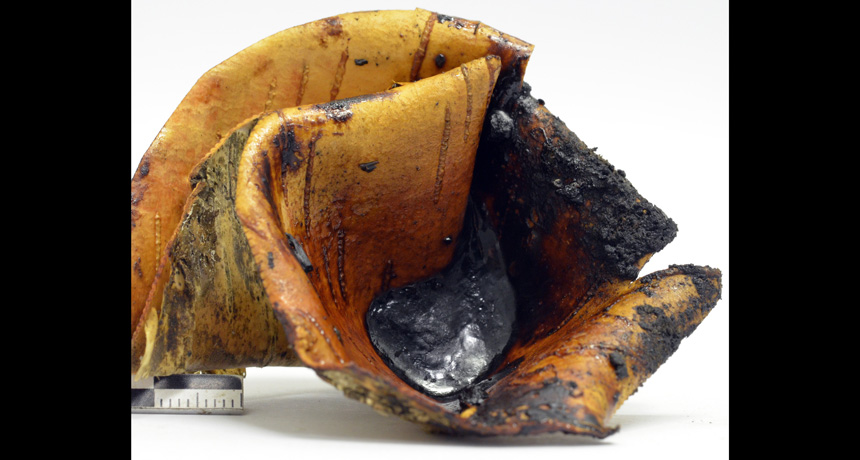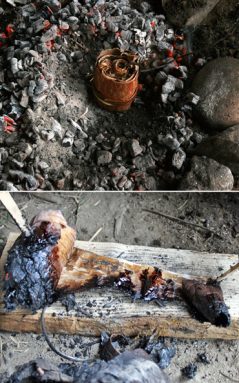Fiery tests suggest gooey tech by Neandertals
Ancient human cousins could have produced tar using simple methods

Using a simple technique, researchers made tar and collected it in a container made of birch bark. Neandertals could have done the same thing some 200,000 years ago.
P. Kozowyk
By Bruce Bower
Neandertals succeeded by sticking to it. They used tar, a dark goo made from wood or coal, to affix handles to sharp-edged stone tools. This let them fashion spears and chopping tools. A new study says our evolutionary cousins could have figured out how to make tar using just scraps of wood and hot embers.
Researchers turned up tar-coated stones at Neandertal sites in Europe that are at least 200,000 years old. That suggests Neandertals, an extinct species closely related to humans, used tar well before our own species did. The earliest known evidence of Homo sapiens making tar comes from around 70,000 years ago in Africa.
Now, archaeologist Paul Kozowyk of Leiden University in the Netherlands and colleagues have re-created the methods Neandertals could have used to make that tar.
Neander-tar
Kozowyk’s group tested three simple ways to make tar. They tried each one between five and 11 times. Each was something they thought ancient folk might have done.
In the lowest-tech approach, they rolled up a piece of bark from a birch tree. Then they tied it with wood fiber and put it under a heap of ashes and embers from a wood fire. Tar formed between the bark layers. Later, the researchers unrolled the bark and scraped off the tar. They could collect nearly one gram (0.04 ounce) of tar this way.

A second technique also started with a roll of birch bark. The researchers now set on fire one end of the roll and then placed it in a small pit. In some cases, they put hot embers on top of the bark. Later, they scraped tar off the bark layers. Or they collected the tar as it dripped off the bark — onto a rock, onto a bark strip or onto a piece of bark folded into a cup. They gathered up about 1.8 grams (0.06 ounce) with this method.
Repeating either of these techniques just once or twice would produce the small amount of tar found at one Neandertal site in Europe, the researchers say. It would take six to 11 repetitions to make the amount of tar unearthed at another site in Europe.
Kozowyk’s team also tried inserting a birch-bark container for collecting tar into a small pit. They layered twigs across the top of the pit, then pebbles on top of that. They topped this all off with a large, loose bark roll, then covered the bark with a dome of wet soil. Afterward, they lit the earthen structure on fire.
This method often failed to produce anything. But with practice, the researchers were able to succeed in one trial. And it produced a whopping 15.7 grams (0.55 ounce) of tar. That’s would have made a lump similar to the largest chunks found at Neandertal sites.
A key to making tar was getting things hot enough. Temperatures inside the bark rolls, vessels, fires and embers varied widely. But at some point each method heated the rolled bark to between 200˚ and 400˚ Celsius (about 400˚ to 800˚ degrees Fahrenheit), Kozowyk says. That’s hot enough to make tar from birch bark, he says.
The researchers think any of these three methods could have produced enough tar to meet a Neandertal’s tool needs.
Previous studies had found that tar lumps at Neandertal sites come from birch bark. Neandertal tar makers didn’t need ceramic containers, such as kilns, to make their tarry glue, the new tests show. And the bark didn’t have to be heated to precise temperatures.
The team described its new findings August 31 in Scientific Reports.
More burning questions
These new data fuel another burning question about Neandertals: Did they know how to build and control fires?
Some researchers think Neandertals controlled fire well enough to build campfires and make products such as tar. Others have argued that Neandertals couldn’t build fires themselves. They must simply have used the remnants of wildfires sparked by lightning.
The new study suggests Neandertals could have invented low-tech tar-making techniques. But it’s still not clear whether they lit the necessary fires on their own.
The new research sheds light on how Neandertals (and likely ancient humans), made tar from birch bark, says Daniel Adler. He’s an archaeologist at the University of Connecticut in Storrs who did not participate in the study. The new tests show that making tar didn’t take advanced knowledge or skills, he adds.
But if Neandertal tar makers took advantage of naturally occurring fires, they would have had to work quickly. They would likely have relied on a simple technique such as ash mounds, Kozowyk says. If Neandertals knew how to start and control fires, they could have used more complex methods.
In any case, Kozowyk concludes, “Neandertals could have invented tar with only basic knowledge of fire and birch bark.”







